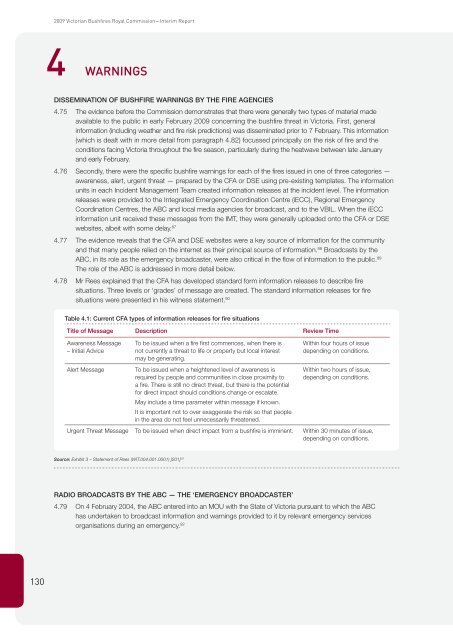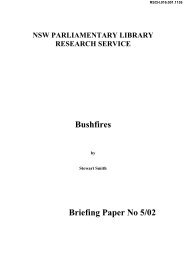Chapter 4 - Warnings - 2009 Victorian Bushfires Royal Commission
Chapter 4 - Warnings - 2009 Victorian Bushfires Royal Commission
Chapter 4 - Warnings - 2009 Victorian Bushfires Royal Commission
You also want an ePaper? Increase the reach of your titles
YUMPU automatically turns print PDFs into web optimized ePapers that Google loves.
<strong>2009</strong> <strong>Victorian</strong> <strong>Bushfires</strong> <strong>Royal</strong> <strong>Commission</strong>—Interim Report<br />
4 WARNINGS<br />
Dissemination of BUSHFIRE warnings by the fire agencies<br />
4.75<br />
4.76<br />
4.77<br />
4.78<br />
The evidence before the <strong>Commission</strong> demonstrates that there were generally two types of material made<br />
available to the public in early February <strong>2009</strong> concerning the bushfire threat in Victoria. First, general<br />
information (including weather and fire risk predictions) was disseminated prior to 7 February. This information<br />
(which is dealt with in more detail from paragraph 4.82) focussed principally on the risk of fire and the<br />
conditions facing Victoria throughout the fire season, particularly during the heatwave between late January<br />
and early February.<br />
Secondly, there were the specific bushfire warnings for each of the fires issued in one of three categories —<br />
awareness, alert, urgent threat — prepared by the CFA or DSE using pre-existing templates. The information<br />
units in each Incident Management Team created information releases at the incident level. The information<br />
releases were provided to the Integrated Emergency Coordination Centre (iECC), Regional Emergency<br />
Coordination Centres, the ABC and local media agencies for broadcast, and to the VBIL. When the iECC<br />
information unit received these messages from the IMT, they were generally uploaded onto the CFA or DSE<br />
websites, albeit with some delay. 87<br />
The evidence reveals that the CFA and DSE websites were a key source of information for the community<br />
and that many people relied on the internet as their principal source of information. 88 Broadcasts by the<br />
ABC, in its role as the emergency broadcaster, were also critical in the flow of information to the public. 89<br />
The role of the ABC is addressed in more detail below.<br />
Mr Rees explained that the CFA has developed standard form information releases to describe fire<br />
situations. Three levels or ‘grades’ of message are created. The standard information releases for fire<br />
situations were presented in his witness statement. 90<br />
Table 4.1: Current CFA types of information releases for fire situations<br />
Title of Message Description Review Time<br />
Awareness Message<br />
– Initial Advice<br />
Alert Message<br />
To be issued when a fire first commences, when there is<br />
not currently a threat to life or property but local interest<br />
may be generating.<br />
To be issued when a heightened level of awareness is<br />
required by people and communities in close proximity to<br />
a fire. There is still no direct threat, but there is the potential<br />
for direct impact should conditions change or escalate.<br />
May include a time parameter within message if known.<br />
It is important not to over exaggerate the risk so that people<br />
in the area do not feel unnecessarily threatened.<br />
Within four hours of issue<br />
depending on conditions.<br />
Within two hours of issue,<br />
depending on conditions.<br />
Urgent Threat Message To be issued when direct impact from a bushfire is imminent. Within 30 minutes of issue,<br />
depending on conditions.<br />
Source: Exhibit 3 – Statement of Rees (WIT.004.001.0001) [201] 91<br />
RADIO Broadcasts by the ABC — the ‘emergency broadcaster’<br />
4.79 On 4 February 2004, the ABC entered into an MOU with the State of Victoria pursuant to which the ABC<br />
has undertaken to broadcast information and warnings provided to it by relevant emergency services<br />
organisations during an emergency. 92<br />
130
















